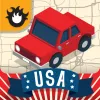Take a look inside 5 images
Geography Drive USA
Pros: Quizzes and mini-games are consistently challenging and amusing. Great visuals and charming interface will easily engage kids.
Cons: The purpose of visiting all 50 states isn't clear, and some users might find the Visitor Center a little dry.
Bottom Line: This is a fun way to explore the history and geography of the United States, but look elsewhere for deep learning.
Encourage kids to research the various regions and routes listed in the Visitor Center. What makes them distinctive? What are the differences and similarities among the various geographic features?
Geography Drive USA is a game that challenges kids to explore all 50 states through quizzes and mini-games. Kids start by customizing a car they'll ride across the country. As they visit each state, kids take a three-question trivia challenge on history, geography, and fun facts about the state (including its nickname or postal code). Kids win cash for correct answers, which adds to their fuel (needed to continue to play). A "Sorry" appears for incorrect answers. Tap on a multiple-choice answer or drag a green star to answer other questions on maps. When kids master a state, they can choose the next border state to move onto, but don't run out of gas!
After kids clear all 50 states, they can continue to play, upgrading their car to something fancier and earning increasingly high scores in the mini-games. Kids can also use the Visitor Center to explore brochures about individual states, geographic features, and famous routes.
The three-question state-pass quizzes are pretty simple, and the mini-games, which feature all 50 states, can get a little tedious. However, some mini-games offer great challenges (the state flag quiz at the Arizona State Fair is hard!), and there’s an appropriate margin for error in each game. That’s an especially useful feature in the game in which kids identify states by shape; luckily, enough wrong answers are allowed to prevent users from losing the game when they mistake one rectangular state for another.
Even bigger challenges lie in the fueling-station quizzes featuring the U.S. map. These questions require serious knowledge, especially of the Hawaiian islands and Alaska. It’s also nice that the famous routes cover such a range of American history, from the transcontinental railroad to the Trail of Tears to the Intracoastal Waterway. The only drawback is that there’s no explanation of why these routes are important or what makes the geographic regions distinct. That kind of detail lies outside the realm of the game: Kids can learn information by rote here, but they’ll have to look elsewhere for depth.
Ultimately, this game may not require deep understanding of U.S. history and geography, but it’s a consistently engaging way to learn facts about all 50 U.S. states.












